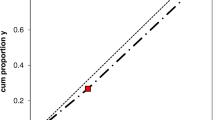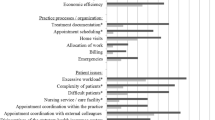Abstract
One hundred and eighty-four physicians or General Practitioners (GPs) in the five Divisions of General Practice in Rural New South Wales, Australia, completed scales designed to assess Workplace Stressors, Negative Affect caused by stressors, General Work Stress, Other Stress, and General Health. GP Stress was positively correlated with Negative Affect, General Work Stress, poor Psychological Health, poor Somatic Health, Anxiety, Social Dysfunction, and Depression. Results showed that the Rural GP Stress Scale (scale that assessed the presence of stressors in the GPs' work environment) possessed concurrent or criterion validity. Factor analysis of GP Stress scores revealed Workload, Family and Leisure Considerations, Bureaucratic Interference, Education and Training Considerations, and Professional Isolation as five of the nine major stressors in the GPs' work environment. Re-testing, 4–6 weeks later, revealed that the Rural GP Stress Scale was highly reliable.
Similar content being viewed by others
References
Bernstein, D. A., & Borkovec, T. D. (1973).Progressive relaxation training: A manual for the helping professions. Champaign, IL: Research Press.
Cooper, C. L., Rout, U., & Faragher, B. (1989). Mental health, job satisfaction, and job stress in general practitioners.British Medical Journal, 298, 366–370.
Cooper, C. L., Sloan, S. J., & Williams, S. (1988).Occupational stress indicator management guide. Windsor: NFER-Nelson.
Deckard, G., Meterko, M., & Field, D. (1994) Physician burnout: An examination of personal, professional and organizational relationships.Medical Care, 32, 745–754.
Dua, J. (1990). Assessment of positive and negative affect as a result of thoughts and real-life experiences.Behaviour Change, 7, 62–65.
Dua, J. K. (1994). Job stressors and their effects on physical health, emotional health, and job satisfaction in a university.Journal of Education Administration, 32, 59–78.
Dua, J., & Price, I. (1992). Psychometric analysis of the subscales of the thoughts and real-life experiences scale.Behaviour Change, 9, 104–111.
Estep, R., Novack, J. A., & Helsel, D. G. (1989). Impaired small town physicians and their spouses.Journal of Drug Issues, 19, 351–367.
Everly, Jr., G. S. (1989).A clinical guide to the treatment of human stress response. New York: Plenum Press.
Goldberg, D., & Williams, P. (1988).A user's guide to the general health questionnaire. Windsor: NFER-Nelson.
Green, A., Duthie, H. L., Young, H. L., & Peters, T. J. (1990). Stress in surgeons.British Journal of Surgeons, 77, 1154–1158.
Hamburg, D. A., Elliott, G. R., & Parron, D. L. (Eds.) (1982).Health and behavior: Frontiers of research in the biobehavioral sciences. Washington, D. C.: National Academy Press.
Holmes, T. H., & Rahe, R. H. (1967). The social adjustment rating scale.Journal of Psychosomatic Research, 11, 213–218.
Ivancevich J. M., & Matteson, M. T. (1987). Organizational level stress management interventions: A review and recommendations. In J. M. Ivancevich & D. C. Ganster (Eds.),Job stress: From theory to suggestion (pp. 229–248). New York: The Howarth Press.
Kahn, R. L., Wolfe, D. M., Quinn, R. P., Snoek, J. D., & Rosenthal, R. A. (1964).Role stress: Studies in role conflict and ambiguity. New York: John Wiley.
Kanner, A., Coyne, J., Schaefer, C., & Lazarus, R. (1981). Comparison of two modes of stress measurement: Daily hassles and uplifts versus major life events.Journal of Behavioral Medicine, 4, 1–39.
Kaplan, R. D., Co, S., French, Jr., J. R. P., Van Harrison, R., & Pinneau, Jr., S. R. (1975).Job demands and worker health. Washington, D. C.: U. S. Department of Health, Education, and Welfare.
Kiecolt-Glaser, J. K., et al. (1985). Distress and DNA repair in human lymphocytes.Journal of Behavioral Medicine, 8, 311–320.
King, M. B., Cockeroft, A., & Gooch, C. (1992). Emotional distress in doctors: Sources, effects and help sought.Journal of the Royal Society of Medicine, 85, 605–608.
Lazarus, R. S. (1966).Psychological stress and the coping process. New York: McGraw-Hill.
Matteson, M. T., & Ivancevich, J. M. (1987).Controlling work stress: Effective human resource and management strategies. San Francisco: Jossey Bass Publishers.
Myerson, S. (1991). Doctors methods of dealing with ‘on going’ stress in general practice.Medical Science Research, 19, 267–269.
Nowack, K. M. (1990). Initial development of an inventory to assess stress and health risk.American Journal of Health Promotion, 4, 173–180.
Olkinuora, M., Asp, S., Juntunen, J., Kauttu, K., Strid, L., & Aarimaa, M. (1990). Stress symptoms, burnout and suicidal thoughts in Finnish physicians.Social Psychiatry and Psychiatric Epidemiology, 25, 81–86.
Pastor, W. H., Huset, R. A., & Lee, M.-C. (1989). Job and life satisfaction among rural physicians: Results of a survey.Minnesota Medicine, 72, 215–223.
Revicki, D. A., & May, H. J. (1983). Development and validation of the Physician Stress Inventory.Family Practice Research Journal, 2, 211–225.
Selye, H. (1976).The stress of life. New York: McGraw-Hill.
Spielberger, C. D., Gorsuch, R. L., Lusbene, R., Vagg, P. R., & Jacobs, G. A. (1983).State-Trait Anxiety Inventory. Palo Alto, CA: Consulting Psychologists Press.
Sutherland, V. J., & Cooper, C. L. (1993). Identifying distress among general practitioners: Predictors of psychological ill-health and job dissatisfaction.Social Science Medicine, 37, 575–581.
Theorell, T., Ahlberg-Hulten, G., Sigala, F., Perski, A., Soderholm, M. Kallner, A. & Eneroth, P. (1990). A psychosocial and biomedical comparison between men in six contrasting service occupations.Work and Stress, 4, 51–63.
Tolhurst, H. M., Ireland, M. C., & Dickinson, J. A. (1990). Emergency and after-hours work performed in country hospitals.The Medical Journal of Australia, 153, 458–465.
Winter, J. E. (Ed.) (1983).Coping with executive stress. New York: McGraw-Hill.
Author information
Authors and Affiliations
Rights and permissions
About this article
Cite this article
Dua, J. Development of a scale to assess occupational stress in Rural General Practitioners. Int J Stress Manage 3, 117–128 (1996). https://doi.org/10.1007/BF01857720
Issue Date:
DOI: https://doi.org/10.1007/BF01857720




